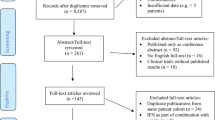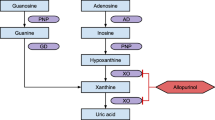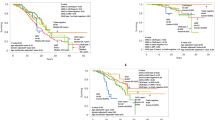Abstract
A widely accepted definition of resistance or intolerance to hydroxyurea (HU) in patients with essential thrombocythemia (ET) is lacking. An international working group (WG) was convened to develop a consensus formulation of clinically significant criteria for defining resistance/intolerance to HU in ET. To this aim, an analytic hierarchy process (AHP), a multiple-attribute decision-making technique, was used. The steps consisted of selecting the candidate criteria for defining resistance/intolerance; identifying the motivations that could influence the preference of the WG for any individual criterion; comparing the candidate criteria in a pair-wise manner; and grading them according their ability to fulfill the motivations. Every step in the model was derived by questionnaires or group discussion. The WG proposed that the definition of resistance/intolerance should require the fulfillment of at least one of the following criteria: platelet count greater than 600 000/μl after 3 months of at least 2 g/day of HU (2.5 g/day in patients with a body weight over 80 kg); platelet count greater than 400 000/μl and WBC less than 2500/μl or Hb less than 10 g/dl at any dose of HU; presence of leg ulcers or other unacceptable muco-cutaneous manifestations at any dose of HU; HU-related fever.
This is a preview of subscription content, access via your institution
Access options
Subscribe to this journal
Receive 12 print issues and online access
$259.00 per year
only $21.58 per issue
Buy this article
- Purchase on Springer Link
- Instant access to full article PDF
Prices may be subject to local taxes which are calculated during checkout

Similar content being viewed by others
References
Yabro JW . Mechanism of action of hydroxyurea. Semin Oncol 1992; 19: 1–10.
Tefferi A, Silverstein MN, Hoagland HC . Primary thrombocythemia. Semin Oncol 1995; 22: 334–340.
Randi ML, Ruzzon E, Tezza F, Luzzatto G, Fabris F . Toxicity and side effects of hydroxyurea used for primary thrombocythemia. Platelets 2005; 16: 181–184.
Najean Y, Rain JD . Treatment of polycythemia: the use of hydroxyurea and pipobroman in 292 patients under the age of 65 years. Blood 1997; 90: 3370–3377.
Barbui T, Finazzi G . When and how to treat essential thrombocythemia. N Engl J Med 2005; 353: 85–86.
Dingli D, Tefferi A . A critical review of anagrelide therapy in essential thrombocythemia and related disorders. Leuk Lymphoma 2005; 46: 641–650.
Barbui T, Barosi G, Grossi, Gugliotta L, Liberato LN, Marchetti M et al. Practice guidelines of the therapy of essential thrombocythemia. A statement from the Italian Society of Hematology, the Italian Society of Experimental Hematology and the Italian Group for Bone Marrow Transplantation. Haematologica 2004; 89: 215–232.
Harrison CN, Campbell PJ, Buck G, Wheatley K, East CL, Bareford D et al. United Kingdom Medical Research Council Primary Thrombocythemia 1 Study. Hydroxyurea compared with anagrelide in high-risk essential thrombocythemia. N Engl J Med 2005; 353: 33–45.
Randi ML, Ruzzon E, Luzzatto G . Safety profile of hydroxyurea in the treatment of patients with Philadelphia-negative chronic myeloproliferative disorders. Haematologica/Hematol J 2005; 90: 261–262.
Silver RT . Anagrelide is effective in treating patients with hydroxyurea-resistant thrombocytosis in patients with chronic myeloid leukemia. Leukemia 2005; 19: 39–43.
Committee of medical products for human use. European Public Assessment Report (EPAR). http://www.emea.eu.int/humandocs/PDFs/EPAR/Xagrid.
Saaty TL, Vargas LG . Prediction, Projection and Forecasting: Applications of the Analytic Hierarchy Process in Economics, Finance, Politics, Games and Sports. Springer: New York, NY, 1990.
William PL, Webb C . The Delphi technique: a methodological discussion. J Adv Nurs 1994; 19: 180–186.
Delbecq AL, van de Ven AH, Gustafson DH . Group Techniques for Program Planning: A Guide to Nominal Group and Delphi Processes. Scott, Foresman and Co: Glenview, IL, 1975.
Wallace CA, Ruperto N, Giannini E . Childhood Arthritis and Rheumatology Research Alliance; Pediatric Rheumatology International Trials Organization; Pediatric Rheumatology Collaborative Study Group. Preliminary criteria for clinical remission for select categories of juvenile idiopathic arthritis. J Rheumatol 2004; 31: 2290–2294.
Barosi G, Bordessoule D, Briere J, Cervantes F, Demory JL, Dupriez B et al. European Myelofibrosis Network. Response criteria for myelofibrosis with myeloid metaplasia: results of an initiative of the European Myelofibrosis Network (EUMNET). Blood 2005; 15: 2849–2853.
Dolan JG . Involving patients in decisions regarding preventive health interventions using the analytic hierarchy process. Health Expectations 2000; 3: 37–45.
Hummel JM, Snoek GJ, van Til JA, van Rossum W, Ijzerman MJ . A multicriteria decision analysis of augmentative treatment of upper limbs in persons with tetraplegia. J Rehabil Res Dev 2005; 42: 635–644.
Singh S, Dolan JG, Centor RM . Optimal management of adults with pharyngitis – a multi-criteria decision analysis. BMC Med Inform Decis Mak 2006; 6: 14–27.
Hariharan S, Dey PK, Chen DR, Moseley HS, Kumar AY . Application of analytic hierarchy process for measuring and comparing the global performance of intensive care units. J Crit Care 2005; 20: 117–124.
Harmanec D, Leong TY, Sundaresh S, Poh KL, Yeo TT, Ng I et al. Decision analytic approach to severe head injury management. Proc AMIA Symp 1999, 271–275.
Acknowledgements
This work was based on an initiative of the European LeukemiaNet within the 6th European Community Framework Programme for Research and Technological Development. This work was supported by a grant from Shire.
Author information
Authors and Affiliations
Corresponding author
Rights and permissions
About this article
Cite this article
Barosi, G., Besses, C., Birgegard, G. et al. A unified definition of clinical resistance/intolerance to hydroxyurea in essential thrombocythemia: results of a consensus process by an international working group. Leukemia 21, 277–280 (2007). https://doi.org/10.1038/sj.leu.2404473
Received:
Revised:
Accepted:
Published:
Issue Date:
DOI: https://doi.org/10.1038/sj.leu.2404473
Keywords
This article is cited by
-
Significant association of cutaneous adverse events with hydroxyurea: results from a prospective non-interventional study in BCR-ABL1-negative myeloproliferative neoplasms (MPN) - on behalf of the German Study Group-MPN
Leukemia (2021)
-
Ruxolitinib-treated polycythemia vera patients and their risk of secondary malignancies
Annals of Hematology (2021)
-
Ruxolitinib-based combinations in the treatment of myelofibrosis: worth looking forward to
Annals of Hematology (2020)
-
Prefibrotic myelofibrosis: treatment algorithm 2018
Blood Cancer Journal (2018)
-
Splanchnic vein thrombosis in myeloproliferative neoplasms: treatment algorithm 2018
Blood Cancer Journal (2018)



